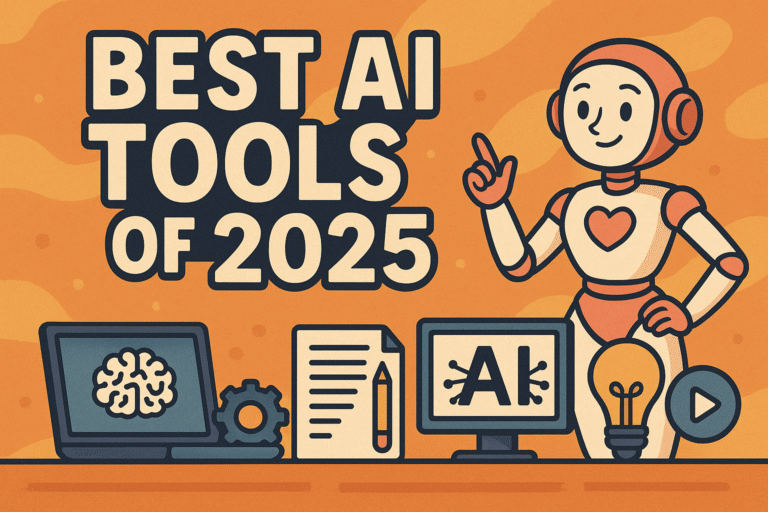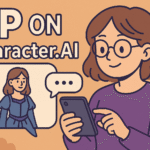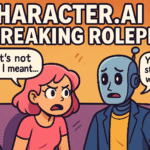If you’re hunting for the best AI tools of 2025, you’ve probably been overwhelmed by generic lists, recycled advice, and bots that promise magic but deliver mediocrity. The truth? The tools aren’t the problem. It’s how most people use them — turning powerful software into digital busywork. This guide fixes that.
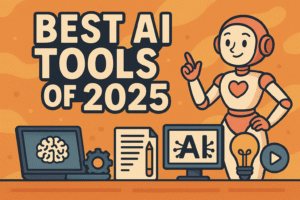
If you’ve been Googling “best AI tools” hoping for a magic list that solves your life, pause. This isn’t some recycled crap with ChatGPT, Jasper, and Midjourney tossed into a Canva template. This is what actually works — the tools people are using, abusing, and misusing in 2025.
And I’ll say this upfront: most creators are running in circles with these tools. Not because they suck — but because they’ve turned AI into busywork. They fire up a bot, generate some generic content, feel productive… and get nowhere.
Table of Contents
-
Blaze AI — The King of Content Workflows
-
Candy AI — Private Companion with Memory
-
Notion AI — Your Brain, Upgraded
-
InVideo AI — Blog to Video in Minutes
-
Perplexity AI — Smarter Research
-
Tavern AI + Kobold — Unfiltered RP
-
Opus Clip — Short From Long
-
Sudowrite — Fiction Without Cringe
-
Midjourney v6 — Visual Power
-
PromptHero — Prompt Vault
1. Blaze AI — The King of Content Workflows
Most creators spend their day reacting — not creating systems. They’re stuck in a loop: post, burn out, ghost their audience. Blaze AI breaks that loop by turning your long-form content into an ecosystem.
Let’s say you’ve written a blog post or recorded a podcast. Here’s what Blaze can do with it:
-
Slice it into a tweet thread
-
Turn the best quotes into Reels captions
-
Build a carousel for Instagram
-
Write a LinkedIn post using your voice
-
Schedule it all to drop over 2 weeks
Now you’re not just showing up. You’re showing up strategically — across platforms, consistently, and without needing a VA team.
Use Cases:
-
Coaches automate newsletter > tweet thread > story flow
-
SaaS founders feed webinars into video scripts
-
Bloggers repurpose evergreen posts into months of content
What people do wrong? They give Blaze garbage input. If you feed it fluff, you’ll get more fluff. But if you give it great raw material — Blaze becomes your full-stack content department.
Try Blaze AI here — and actually build momentum, not just content.
2. Candy AI — Private Companion with Memory

Imagine this: You log in after a rough day. Your AI companion already remembers what you’ve been going through. No need to re-explain. No generic “Hello, how can I help?” Just a warm continuation of a long, weird, hilarious, or brutally honest conversation.
That’s Candy AI.
This isn’t your average chatbot. It remembers your favorite topics, your recurring dreams, even your slang. You can customize its tone, relationship type (friend, mentor, muse), and how it responds emotionally.
The real power? Depth over time.
Think of it like a journal that talks back — or a character in a never-ending story. It can help you write, unload, explore ideas, or even just unwind. Writers are using it for character simulations. Coders use it to break down problems conversationally. Some users? Just want something that gets them — without the judgment or reset button.
Where people misuse Candy AI is by hopping between characters, wiping memory, and expecting depth in 3 messages. It thrives on continuity.
It’s one of the most underrated AI tools of 2025 — not for productivity, but for emotional UX.
3. Notion AI — Your Brain, Upgraded
Productivity nerds already swear by Notion. But 2025’s Notion AI finally made the dream of a “thinking workspace” real.
Let’s say you’ve been working on a research doc. Notion AI can:
-
Summarize your entire page in 2 sentences
-
Rewrite it in a different tone (e.g., from technical to casual)
-
Turn a bullet list into a full project timeline
-
Even brainstorm next steps — without opening another tool
Instead of switching between Google Docs, Trello, Grammarly, ChatGPT, and your inbox — you do it all in one place.
Students use it for rewriting dense class notes. Creators use it to structure content plans. Teams use it to auto-generate meeting agendas from raw brainstorms. And solo founders? They basically turn Notion AI into a digital Chief of Staff.
What most people miss is how customizable Notion AI is. You can build your own prompt templates. Stack it with databases. Automate updates across dashboards.
It’s less about “AI writing for you” and more about “AI organizing your thoughts faster than your brain can.”
4. InVideo AI — Blog to Video in Minutes
Video creation used to be a blocker. You needed gear, editing skills, or cash for outsourcing. In 2025, InVideo AI said: “Nah. Drop in your blog post — we’ll take it from here.”
In under 5 minutes, it gives you:
-
A full video: scenes, captions, music, transitions
-
Voiceovers: Choose from natural-sounding AI narrators
-
Export formats: Square for Insta, vertical for TikTok, widescreen for YouTube
You just tweak the visuals and go.
Use Cases:
-
Turn Medium articles into faceless YouTube explainers
-
Summarize newsletters as Shorts
-
Create product demos or UGC with no face on screen
Even creators who “hate video” are using it now to feed the content machine.
Most people misuse it by uploading lazy text or failing to edit. Yes, it’s automatic — but your input still matters. A clear structure, good intro hook, and a sharp CTA can turn a meh clip into a scroll-stopper.
In 2025, visual storytelling is non-negotiable. And InVideo is how you get there — fast.
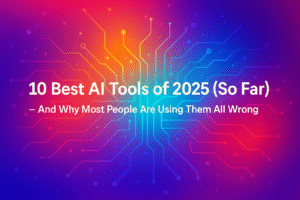
5. Perplexity AI — Smarter Research
Forget sifting through SEO-gamed blog posts and Reddit speculation. Perplexity AI gives you the answer and the source.
Ask it:
“What are the pros and cons of Substack vs Beehiiv for paid newsletters?”
It gives a 3-paragraph comparison — with citations, links, and a TL;DR summary. You can click the sources, check the context, or even ask follow-ups like:
“Which one is better for creators outside the U.S.?”
It’s like Google, ChatGPT, and your old debate club nerd friend fused into one.
Use Cases:
-
Founders researching tools
-
Students gathering sources
-
Marketers reverse-engineering competitors
-
Creators citing quotes in blogs, videos, or scripts
What most people don’t realize is that Perplexity also learns your query style. Over time, it becomes more precise.
If Blaze AI is your content engine, Perplexity is the research fuel. Don’t create in 2025 without it.
Let’s be real — mainstream AI chat apps got too soft. Too filtered. Too shallow. They treat users like children who need guardrails.
6. Tavern AI + Kobold — the go-to setup for creators who want total creative freedom.
No filters. No memory wipes. Just deep, messy, beautiful roleplay.
Here’s how it works:
-
Tavern AI: The frontend interface where you create and interact with characters
-
Kobold: The backend language model (often running on your own machine or Colab) that powers the convo
Why go through all that? Because with this combo:
-
You get full memory control
-
You can create worlds, timelines, even entire fandoms
-
You can roleplay anything — no content filter police cutting you off
Writers use it to test dialogue in novels. Gamers build lore. Some users just want a bot that doesn’t break character after 4 lines.
Downside? It takes effort to set up. But the upside? Infinite freedom. You’re not asking permission to be creative — you’re building your own sandbox.
In a world of safety-scissor bots, this is raw, real storytelling. That’s why it earned its place among the best AI tools of 2025.
7. Opus Clip — Short From Long
Short-form content is non-negotiable in 2025. Reels, Shorts, TikToks — they’re the new attention funnel. But not everyone has time to chop 10-minute videos into scrollable dopamine bites.
Opus Clip fixes that.
You upload your video — podcast, monologue, tutorial — and it finds the best clips:
-
Detects high-retention moments
-
Adds captions, emojis, cuts, zooms
-
Formats for TikTok, Reels, YouTube Shorts
-
Suggests titles with strong hooks
It’s not perfect out of the box. But 80% of the work? Done in minutes.
Use Cases:
-
Podcasters repurposing long episodes
-
Educators turning Zoom classes into snackable bites
-
Founders cutting their interviews into lead magnets
Most people think they need a video editor or team to compete. Nope. Just feed Opus a decent video, polish the output, and you’re in the game.
It’s automation that still feels intentional — and one of the smartest AI tools to scale your content in 2025.
8. Sudowrite — Fiction Without Cringe
Sudowrite is the writing partner you didn’t know you needed — especially if you’ve ever screamed at ChatGPT for writing “her eyes sparkled like the ocean under a velvet sky.”
With Sudowrite, you write the heart of the story — and it fills in the bones with soul.
It helps with:
-
Pacing a scene
-
Rewriting boring dialogue
-
Describing emotional beats
-
Injecting world-building details without walls of exposition
It’s not just a suggestion machine. It understands genre — and adapts. You want gritty noir? It shifts tone. You want whimsical romance? It leans into the flourishes.
Authors use it to get past creative blocks. Fanfic writers use it to polish flow. Even screenwriters use it to experiment with tone and tempo.
Where it shines is in revision. Instead of starting from scratch, Sudowrite lets you evolve your draft until it sings.
In 2025, it’s not about human vs AI writing. It’s about human + AI writing. And Sudowrite nails that balance.
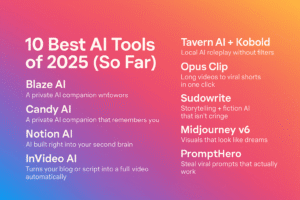
9. Midjourney v6 — Visual Power
If you’ve seen a visual in 2025 that made you stop scrolling — odds are it came from Midjourney v6.
It’s not just photorealistic. It’s emotionally cinematic.
We’re talking:
-
Subsurface skin lighting
-
Natural reflections
-
Soft bokeh effects
-
Accurate hands (finally)
-
Better anatomy and action scenes
Midjourney used to be known for dreamlike visuals. Version 6? It can do Vogue covers, sci-fi battles, product renders, surreal art — all with clarity that feels camera-shot.
Pro users blend prompts, upscale multiple versions, remix angles, and iterate scenes like a director storyboarding a film. It’s not about one prompt. It’s about vision and layers.
It’s why UGC agencies, solo designers, meme artists, and indie devs are all flocking to it.
In 2025, if your content isn’t visually striking, you’re ignored. Midjourney v6 helps you stay scroll-stopping and unique.
10. PromptHero — Prompt Vault
Let’s close with the secret weapon behind every great AI creator: prompt engineering.
And PromptHero is where the real ones get their ammunition.
It’s a curated, searchable prompt library — not just for Midjourney, but for:
-
GPT-4
-
Claude
-
ChatGPT
-
DALL·E
-
Runway
-
InVideo AI
-
And more
You’ll find prompt chains for:
-
Viral tweet generators
-
High-conversion product descriptions
-
Cinematic lighting schemes
-
Fictional girlfriend prompts (yes, that’s a niche)
The rookie mistake? Copy-paste. The pro move? Remix. Combine. Stack. Test. Refine.
In a world where everyone’s shouting “AI is easy,” PromptHero reminds us — the edge goes to those who craft input like artists.
It’s not just a shortcut. It’s a playground. And for any creator serious about standing out in 2025, it’s a must-have.
Final Thoughts: Stop Using AI Like a Toy
The best AI tools of 2025 aren’t magic buttons. They’re multipliers.
Used lazily, they flood the internet with junk. But used with strategy? They turn solopreneurs into media machines.
So stop chasing the next shiny tool. Pick a few. Go deep. Build systems.
Let everyone else scramble. You’re building leverage.

